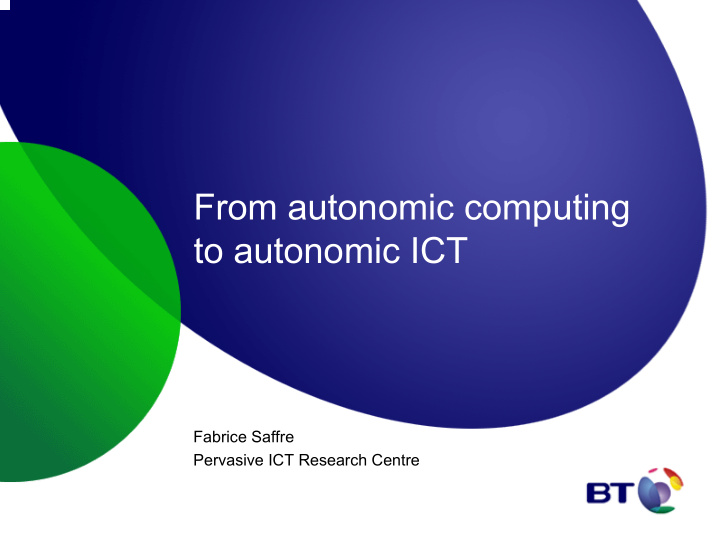



From autonomic computing to autonomic ICT Fabrice Saffre Pervasive ICT Research Centre
Fabrice Saffre, 2005 Autonomic principles • The trend towards self-configuration, self-protection etc. championed by IBM is widely referred to as “autonomic computing”. • Though finding its origin in “pure” research (biologically inspired systems), it has gained so much momentum and widespread endorsement that many implementations now exist. • However, they are mostly “node-centric” as opposed to “network-centric”. • This creates the perfect conditions for complex system behaviour (many interacting units making autonomous/selfish decisions on the basis of locally available information).
Fabrice Saffre, 2005 Expected benefits • More agile computing assets, capable of responding adaptively to unique, changing and unpredictable user demands. • More robust software, capable of self-diagnostic and of actively and autonomously seeking to avoid “unsafe” configurations. • Reduced cost of ownership (i.e. a direct and highly desirable consequence of increased robustness). • Reduced “downtime” (ibid).
Fabrice Saffre, 2005 The origins of complexity • Networks are becoming so dynamic and complicated that the only viable management option is to make them complex… • Because we have no choice but to gradually switch from centralised to decentralised control, we are effectively sowing the seeds of complexity. • We must learn to live with and take advantage of the emergent properties arising from the interaction of many system constituents, not try to counter them.
Fabrice Saffre, 2005 Self-organisation • By definition , a system composed of units making autonomous decisions based on locally available information can only be “driven” to a desirable state by leveraging self-organisation. • This requires engineering the reasoning and decision-making engine running on individual units so as to promote the emergence of the “right” collective behaviour. • In turn, this means adapting the predictive techniques of natural complexity science (both analytical and numerical) to meet the needs of artificial complex systems designers. • It seems relatively trivial in principle , but experimental validation requires prototype implementation, which is a serious issue.
Fabrice Saffre, 2005 Practical applications • Autonomic service deployment: module-based applications could greatly benefit from “on-the-fly” adjustment to unpredictable usage patterns (i.e. “who needs what service, where and when?”). • Autonomic resources accounting and allocation: “on-demand” distributed computing (i.e. seamless Grid) requires real-time balancing of the offer and demand, which could be achieved via unsupervised negotiation between potential collaborators. • Self-organising ad-hoc networks: social differentiation (specialisation) and/or decentralised radio spectrum management (e.g. via cross-inhibition) can enhance usability and/or longevity.
Fabrice Saffre, 2005 Conclusion • The borders between: – Autonomic computing/communication – Networking and services – Pervasive computing – Resource sharing – Software design and engineering are fading rapidly… • Because they all share the same problem: less control, increased complexity, poor understanding of artificial systems’ emergent properties.
Fabrice Saffre, 2005 Conclusion (2) • The corresponding industries have increasingly overlapping markets with, e.g., Telcos and IT companies now competing to provide ICT services. • The race is on, and whoever can demonstrate that they’ve “cracked the complexity nut” in practice will have a decisive advantage. • Because they will be able to offer new and cheap ICT solutions that are predictably and reliably efficient in the unpredictable and unreliable world of the “network economy”.
Recommend
More recommend